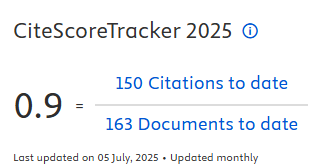Relationship Between Pesticide Exposure and Neurobehavioral Disorders in Farmers

Downloads
Introduction: Pesticides are chemicals used to eradicate pests such as insects that damage crops and agricultural products. Farmers often do not realize that the benefits of pesticides are important for agriculture but also have dangerous risks. If farmers are constantly exposed to pesticides this can cause neurological diseases. The purpose of this study was to determine the relationship between exposure to pesticides and neurobehavioral disorders in farmers. Methods: The authors of this study conducted research using a systematic literature review on publications published in the last 5 years on two databases namely Google Scholar and Scopus using the keywords pesticides, neurobehavioral, and farmers. The literature review was conducted based on issues, methodology, similarities and further research proposals. The population was all farmers in Indonesia who work with pesticides on their crops. Results: Three of the four articles found reported that pesticide exposure and duration of action were associated with neurobehavioral events whereas one article did not state any association between these variables. Some neurobehavioral symptoms caused by pesticide exposure are dizziness, difficulty sleeping, and difficulty concentrating. Conclusion: The use of pesticide content must be balanced to minimize the risks caused by exposure. Farmers also have to get enough rest to restore the function of the cholinesterase enzyme in the blood. It can be concluded that exposure to pesticides is associated with neurobehavioral events in farmers.
Aji, S. P. and Anantanyu, S. (2022) ‘Alzheimer Dan Gejala Sistem Saraf (Neurologis) Akibat Pestisida', Public Health and Safety International Journal (PHASIJ), 2(1), pp. 2715–5854. doi: 10.55642.
Gusti, A. and Desnizar, I. (2017) ‘Faktor-Faktor Yang Berhubungan dengan Gejala Neurotoksik Akibat Paparan Pestisida pada Petani Sayuran di Kenagarian Alahan Panjang Kabupaten Solok', Jurnal Kesehatan Lingkungan Indonesia, 16(1), pp. 17–21.
Joko, T., Dewanti, N. A. Y. and Dangiran, H. L. (2020) ‘Pesticide Poisoning and the Use of Personal Protective Equipment (PPE) in Indonesian Farmers', Journal of Environmental and Public Health, 2020, pp. 1–7. doi: 10.1155/2020/5379619.
Li, J. et al. (2019) ‘Relationship between Cumulative Exposure to Pesticides and Sleep Disorders among Greenhouse Vegetable Farmers', BMC Public Health, 19(1), pp. 1–11. doi: 10.1186/s12889-019-6712-6.
Meirindany, T., Indirawati, S. M. and Marsaulina, I. (2021) ‘Hubungan Pajanan Pestisida dengan Efek Neurobehavioral pada Petani Cabai Merah di Kecamatan Beringin', Jurnal Health Sains, 2(3), pp. 410–419.
Mustakim, M. and Kas, S. R. (2023) ‘Hubungan Paparan Pestisida Pada Petani Sayuran Dengan Efek Neurobehavioral Di Desa Pana Kabupaten Enrekang', Jurnal DinamikaKesehatan Masyarakat, 1(1), pp. 28–33.
Pawestri, I. N. and Sulistyaningsih, E. (2021) ‘Neurobehavioral Performance of Indonesian Farmers and its Association with Pesticide Exposure: A Cross-sectional Study', Clinical Epidemiology and Global Health, 11, pp. 1–5. doi: 10.1016/j.cegh.2021.100754.
Pratama, D. A., Setiani, O. and Darundiati, Y. H. (2021) ‘Pesticide Exposure Factors Related To Neurological Symptoms In Farmers Spraying Pesticides', International Journal of Health, Education and Social (IJHES), 4(11), pp. 83–93.
Rahmawaty, R. et al. (2019) ‘Diversity and Distribution of Medicinal Plants in the Universitas Sumatera Utara Arboretum of Deli Serdang, North Sumatra, Indonesia', Biodiversitas, 20(5), pp. 1457–1465. doi: 10.13057/biodiv/d200539.
Ramírez-Santana, M. et al. (2020) ‘Reduced Neurobehavioral Functioning in Agricultural Workers and Rural Inhabitants Exposed to Pesticides in Northern Chile and its Association with Blood Biomarkers Inhibition', Environmental Health: A Global Access Science Source, 19(1), p. 84. doi: 10.1186/s12940-020-00634-6.
Tiwari, S. et al. (2022) ‘Association between Pesticide Exposure and Neurobehavioral Performance of Agricultural Workers: A Cross-sectional Study', Brain and Behavior, 12(7), p. e2641. doi: 10.1002/brb3.2641.

This work is licensed under a Creative Commons Attribution-NonCommercial-ShareAlike 4.0 International License.

In order to be accepted and published by The Indonesian Journal of Occupational Safety and Health, Author(s) who submit an article should complete all the review process. The copyright of received articles assigned to the The Indonesian Journal of Occupational Safety and Health and Department of Safety and Health, Universitas Airlangga as publishers of the journal. The intended copyright includes the rights to publish articles in various forms (including reprints).
The Editorial Team of The Indonesian Journal Of Occupational Safety and Health and Department of Safety and Health strive to ensure that no errors occur in the articles that have been published, both data errors and statements in the article.
Users of this website will be licensed to use materials from this website following the Creative Commons Attribution-NonCommercial-ShareAlike 4.0 International License. No fees charged. Please use the materials accordingly.
------------------------------------------------------------------------------------------------------------------------------------------------------------------------------------------
Attribution ” You must give appropriate credit, provide a link to the license, and indicate if changes were made. You may do so in any reasonable manner, but not in any way that suggests the licensor endorses you or your use.
NonCommercial ” You may not use the material for commercial purposes.
ShareAlike ” If you remix, transform, or build upon the material, you must distribute your contributions under the same license as the original.







 How to Submit Articles in OJS
How to Submit Articles in OJS

























